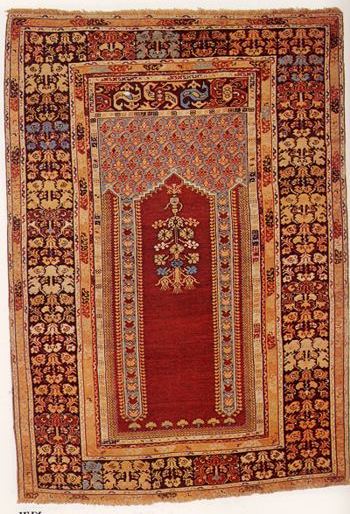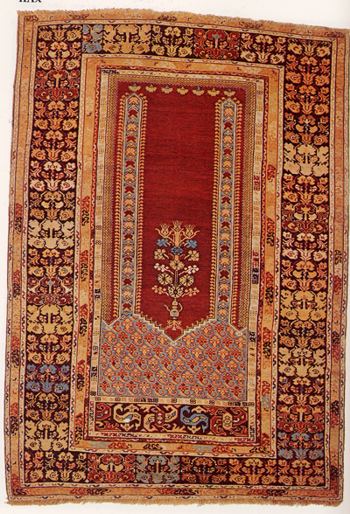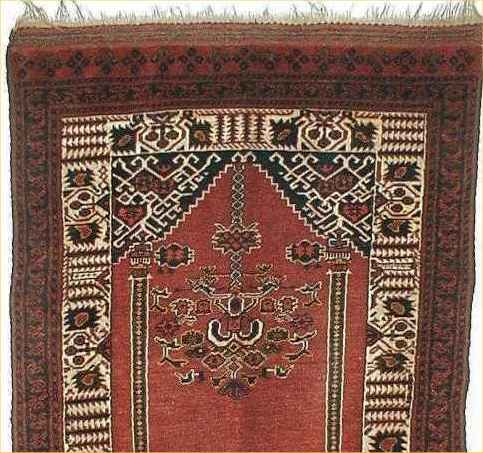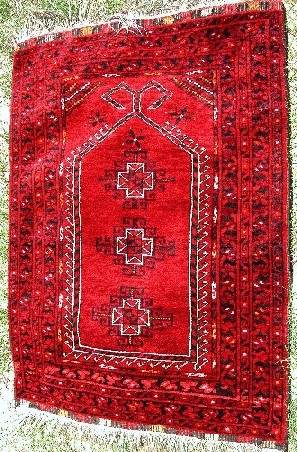Posted by R. John Howe on 12-24-2002 07:48 AM:
"Upside Down" In Relation to Design
Steve -
Many will know this, but it may be useful to mention, here at
the beginning, that many "prayer" rugs are woven upside down in relation to
their design.
I have heard a couple of reasons given for this practice.
The first is that it may make it more certain that the weaver will be
able to draw the area with the arch as desired (that is, the potential problem
of a shortage of warp length at the end finished last, is avoided).
The
second is that it makes the pile flow away from the person praying and therefore
is softer against his hands (and perhaps even his head) during prayer. This
second reason is the same often given for the fact that many saddle covers are
woven so that the pile points down and so is ostensibly smoother against the
inside of the rider's thighs.
Both of these reasons may be apocryphal but
the practice of weaving many rugs with arches in what seems like an upside down
mode is evident.
Regards,
R. John Howe
Posted by Steve Price on 12-24-2002 09:48 AM:
Hi John,
I think one more explanation for the "upside down" weaving
ought to be added to the list: some of the things we call arches aren't arches
at all, and those rugs are woven right side up. Many "arches", when inverted,
look like perfectly respectable vessels or
flowerpots.
Regards,
Steve Price
Posted by Patrick Weiler on 01-01-2003 03:55 PM:
How do you know?
John,
If a rug with a symmetrical field was woven upside down, how
would you know? Technically, a symmetrical-field rug could be said to be half
woven upside down and the other half right side up.  There also may be rugs out there with a
one-way field that were easier to weave upside down, but no one bothered to make
note of it.
There also may be rugs out there with a
one-way field that were easier to weave upside down, but no one bothered to make
note of it.
When weaving the bottom half of a medallion-and-corners rug, the
weaver is actually weaving the "top" of a single niche prayer rug! If it is
quicker to do that on a symmetric rug, then why not weave a single niche rug
with the niche at the start?
What if some prayer rugs were
medallion-and-corner rugs but the weaver ran out of warp and just finished the
field flat across the top!!! 
So, this upside down prayer rug theory may be less important, or at
least may have considerably less meaning than it seems.
Debunkingly
yours,
Patrick Weiler
Posted by Steve Price on 01-02-2003 09:12 AM:
Hi People,
Here is a rug woven upside down if the arch is a mihrab,
rightside up if it is a container for certain motifs. It's a 19th century Kula,
shown as plate XVII in Prayer Rugs, by Ettinghausen, Dimand, Mackie and
Ellis, and is from the Ballard collection.


Notice that the flowers
and ewer in the arch are upside down if the rug is oriented in the "prayer rug"
direction (which is the orientation in the published photo), as are the flowers
in the main border. It appears to me that orienting the rug with the arch at the
top is a perfect example of a lovely hypothesis ("The rug was woven for use as
an appurtenance in Moslem prayer") coming face to face with an ugly fact
("Nearly everything in it is upside down when it is oriented for use in prayer,
but rightside up if it was woven for decorative purposes") and the issue being
resolved by ignoring the fact.
Regards,
Steve Price
Posted by Yon Bard on 01-02-2003 10:22 AM:
Steve, I find looking at the architecture upside down is far more disturbing
than looking at the flowers upside down.
Regards, Yon
Posted by Filiberto Boncompagni on 01-02-2003 10:37 AM:
I like the explanation "it may make it more certain that the weaver will be
able to draw the area with the arch as desired".
Thatís why: if the weaver of
this rug had woven it upside down (which she didnít) she could have avoided the
mistake of hanging the lamp off center.

Regards,
Filiberto
Posted by Steve Price on 01-02-2003 11:32 AM:
Hi Yon,
I don't understand what you mean by the "architecture", but I
don't think the question of which orientation you or I find less visually
disturbing is the crux of the matter anyway.
Many of us have a prejudice
(by this I mean pre-determined notion, which may be correct) that rugs with
arches in their layout were woven for the purpose of being used for Moslem
prayer and that the arch is a mihrab. For simplicity, let's ignore the more or
less obvious exceptions like the Qashqa'i "milleflores" type and the Bezalel
synagogue rugs and, of course, my Kuba khorjin face.
Let's take the Kula
from the Ballard collection and try to see what it tells us about itself in this
regard. When oriented in one direction, it has an arch at the top. But why do we
think that is the top?
1. It's woven from the other end. Not compelling
evidence of anything, really. There seems to be no firm rule relating the
direction of the weaver's progress to the intended direction of viewing the rug.
2. There's a water ewer that's upside down if the arch is at the top.
3.
The flowers in the "arch" are upside down, and so are the flowers in the border.
To make a long story short, the rug has a number of elements in it that
have easily discerned tops and bottoms. Every one of them is upside down if we
place the "arch" at the top. On the other hand, all of them are rightside up
when it is oriented so that the "arch" is seen as a decorative design at the
bottom. While this is not conclusive, it does constitute an evidence-based
argument that the weaver intended the "arch" to be at the bottom. On the other
hand, unless it is assumed that the arch belongs at the top I see no basis for
concluding that it does.
Regards,
Steve Price
Posted by Yon Bard on 01-02-2003 12:12 PM:
Steve, it should be pretty clear what I mean by 'archuitecture.' since the
field (if viewed in the 'proper' way looks like a section of an endless
collonade with pointed arches and a textured ceiling, most reminiscent of
Moorish architecture in Cordoba and Granada. I have seen it hypothesized that
these designs came from spain via the Jews who were expelled in 1492.
I
think the direction of weaving on prayer rugs doesn't mean too much. I have
Beshir prayer rugs woven both ways.
As a prayer rug is used horizontally
on the floor, the concepts of 'up' and 'down' are not as meaningful as one might
think.
Regards, Yon
Posted by Steve Price on 01-02-2003 02:04 PM:
Hi Yon,
The architectural derivation of columns is more obvious on
many rugs than it is on the Kula from the Ballard collection, and on one of
those I would lean more in the direction you do with regard to interpretation.
While "up" and "down" have little meaning when the rug is on the floor, when
used for prayer the arch or mihrab is at the head end, so there is a direction
from which it is viewed. The head end, in that use. is reasonably referred to as
"up", the foot end as "down". When the columns are architectural and support a
representation of a ceiling, directionality is again reasonably called "up" and
"down".
Like you, I find the piece aesthetically more pleasing with the
arch at the top, probably because I don't pay much attention to the
representational details when I look at it.
Regards, and happy new
year,
Steve Price
Posted by Chuck Wagner on 01-10-2003 11:26 AM:
Option 3
Hi all.
I propose that there is a third possibility for occasionally
weaving
prayer rugs "upside-down". An example is this 1950's-ish rug
from
Jangl Areq in NW Afghanistan:

I think it may be a "Light
end vs. Dark end" thing, where the
weaver recognizes that (in the case of a
prayer rug) the user
will almost always be viewing the rug from the bottom
and feels
that the rug will be too dark to really appreciate the
colors
and/or pattern if woven "normally".
This particular rug is
quite dark when viewed from the open pile
end, but quite nice when viewed
over the back of the pile. This
would be less important with pile clipped
very short, such as some
of the Shirvan rugs, etc.
Regards,
Chuck
__________________
Chuck
Wagner
Posted by Kenneth Thompson on 01-13-2003 06:42 PM:
Practical considerations
Dear All,
In the catalog text that accompanies the current exhibition
of Turkish carpets at the Washington Textile Museum, Walter Denny postulates
that niche prayer rugs were woven upside-down in order to assure that the most
difficult part, the "mihrab", was completed first. If the weaver ran out of
space as the warps contracted towards the top, she could finish with a straight
border. I don't have the text at hand or I would quote you Denny's more lucid
explanation.
If you don't have a copy of this publication, it is worth
ordering from the Textile Museum. It is well written and full of common sense
from an expert who has spent most of his life in the carpet and textile
field.
Regards,
Ken
Posted by R. John Howe on 01-14-2003 04:51 PM:
Hi Ken -
Good to hear from you.
Yes, the reason you give here
is the first one I gave at the beginning of this thread, but I certainly agree
that Denny explains it better than either of us.
Regards,
R. John
Howe
 There also may be rugs out there with a
one-way field that were easier to weave upside down, but no one bothered to make
note of it.
There also may be rugs out there with a
one-way field that were easier to weave upside down, but no one bothered to make
note of it. 



